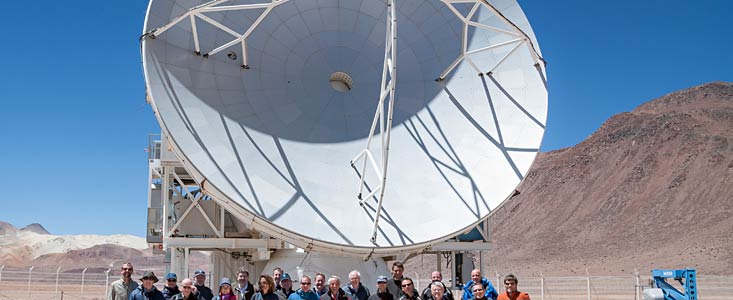A celebration was held at the APEX [1] base station in Sequitor, San Pedro de Atacama, to mark ten years of astronomical research with the APEX telescope, which resides on Chile’s Chajnantor Plateau, 5100 metres above sea level.
From there, the telescope observes the sky in submillimetre wavelengths, giving astronomers access to the coldest regions of the Universe, which cannot be seen in visible light. As it looks forward to further discoveries at the forefront of observational astronomy, the APEX 12-metre telescope has already made significant contributions across a variety of astronomical fields, including the discovery of new interstellar molecules and deep imaging of the submillimetre sky, leading to new insights into star formation in the Milky Way and distant starburst galaxies in the early Universe.
The Sequitor base station was chosen for the celebration, as it is at the more comfortable altitude of 2500 metres above sea level. But participants did have an opportunity to visit the telescope site itself, as our pictures show. A number of special guests were present for the occasion, including the German ambassador to Chile, Rolf Schulze, the president of theMax Planck Society, Martin Stratmann, and the Director General of ESO, Tim de Zeeuw. For the other partners in the APEX collaboration, Karl Menten and project manager Rolf Güsten from the Max Planck Institute for Radio Astronomy (MPIfR) and John Conway from Sweden’s Onsala Space Observatory (OSO) also attended the event.
Notes
[1] Over the last ten years, about 2000 scientists have used data obtained with APEX for science projects, resulting in more than 500 publications. Major APEX results include the discovery of five new molecules in the interstellar medium and also large surveys including ATLASGAL (APEX Telescope Large Area Survey of the Galaxy), and LESS (LABOCA Survey of the Extended Chandra Deep Field South). Both have used the Large APEX Bolometer Camera (LABOCA) to measure the star formation activity in the Milky Way and at early epochs of the Universe. The APEX telescope makes use of its access to the southern sky, in particular the central parts of the Milky Way and the Magellanic Clouds.
Further Information
APEX is a collaboration between the Max Planck Institute for Radio Astronomy (MPIfR), the Onsala Space Observatory (OSO) and ESO. Operation of APEX at Chajnantor is carried out by ESO.
Links
- Atacama Pathfinder EXperiment (APEX)
- Max-Planck-Institute for Radio astronomy (MPIfR)
- Onsala Space Observatory (OSO)
- APEX Telescope Large Area Survey of the Galaxy (ATLASGAL)
- LABOCA Survey of the Extended Chandra Deep Field South (LESS) – p.26
- Atacama Large Millimeter/submillimeter Array (ALMA)
- Speech by ESO Director General Tim de Zeeuw at the APEX celebrations (PDF 48KB)
If our reporting has informed or inspired you, please consider making a donation. Every contribution, no matter the size, empowers us to continue delivering accurate, engaging, and trustworthy science and medical news. Independent journalism requires time, effort, and resources—your support ensures we can keep uncovering the stories that matter most to you.
Join us in making knowledge accessible and impactful. Thank you for standing with us!

